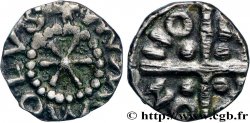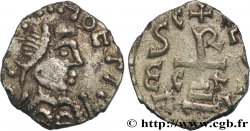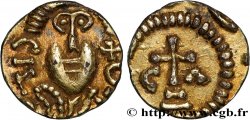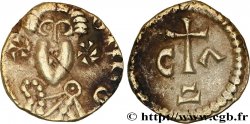bmv_228021 - CHALON-SUR-SAÔNE (CABILONNUM) - Saône-et-Loire Triens, monétaire VINTRIO, faux d’époque
Not available.
Item sold on our e-shop (2010)
Price : 450.00 €
Item sold on our e-shop (2010)
Price : 450.00 €
Type : Triens, monétaire VINTRIO, faux d’époque
Date: VIIe siècle
Mint name / Town : 71 - Chalon-sur-Saône
Metal : gold
Diameter : 12,5 mm
Orientation dies : 6 h.
Weight : 0,81 g.
Rarity : R3
Coments on the condition:
Triens faux d’époque, frappé sur un flan assez large et régulier mais de bronze recouvert d’or. La pellicule d’or est absent u centre du droit, rendant le buste invisible, et sur les parties les plus en relief du revers
Catalogue references :
Obverse
Obverse legend : CABIL-VNNO F +.
Obverse description : Buste à droite, diadème de perles sommé d’un croissant et attaché par trois rubans terminés par des globules ; manteau avec anneau d’attache à l’angle gauche et globules à l’angle droit ; listel.
Reverse
Reverse legend : VVINTRIO MONET.
Reverse description : Croix latine sur deux degrés, accostée de CA, dans un diadème de perles ; légende autour et listel.
Commentary
Cette monnaie appartient au quatrième groupe du monnayage mérovingien attribué à Chalon-sur-Saône, avec la croix (non chrismée) reposant sur l’anneau centré.
VINTRIO est l’un des monétaires le mieux connus du monnayage d’or de Chalon-sur-Saône.
Cet exemplaire fourré a lé particularité d’avoir la croisette en fin de légende au droit et d’avoir VVINTRIO MONE au revers alors que la plupart des exemplaires ont plutôt l'abréviation MON, MONT ou MONI pour monétaire.
VINTRIO est l’un des monétaires le mieux connus du monnayage d’or de Chalon-sur-Saône.
Cet exemplaire fourré a lé particularité d’avoir la croisette en fin de légende au droit et d’avoir VVINTRIO MONE au revers alors que la plupart des exemplaires ont plutôt l'abréviation MON, MONT ou MONI pour monétaire.








 Report a mistake
Report a mistake Print the page
Print the page Share my selection
Share my selection Ask a question
Ask a question Consign / sell
Consign / sell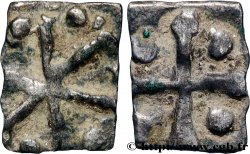
 Full data
Full data